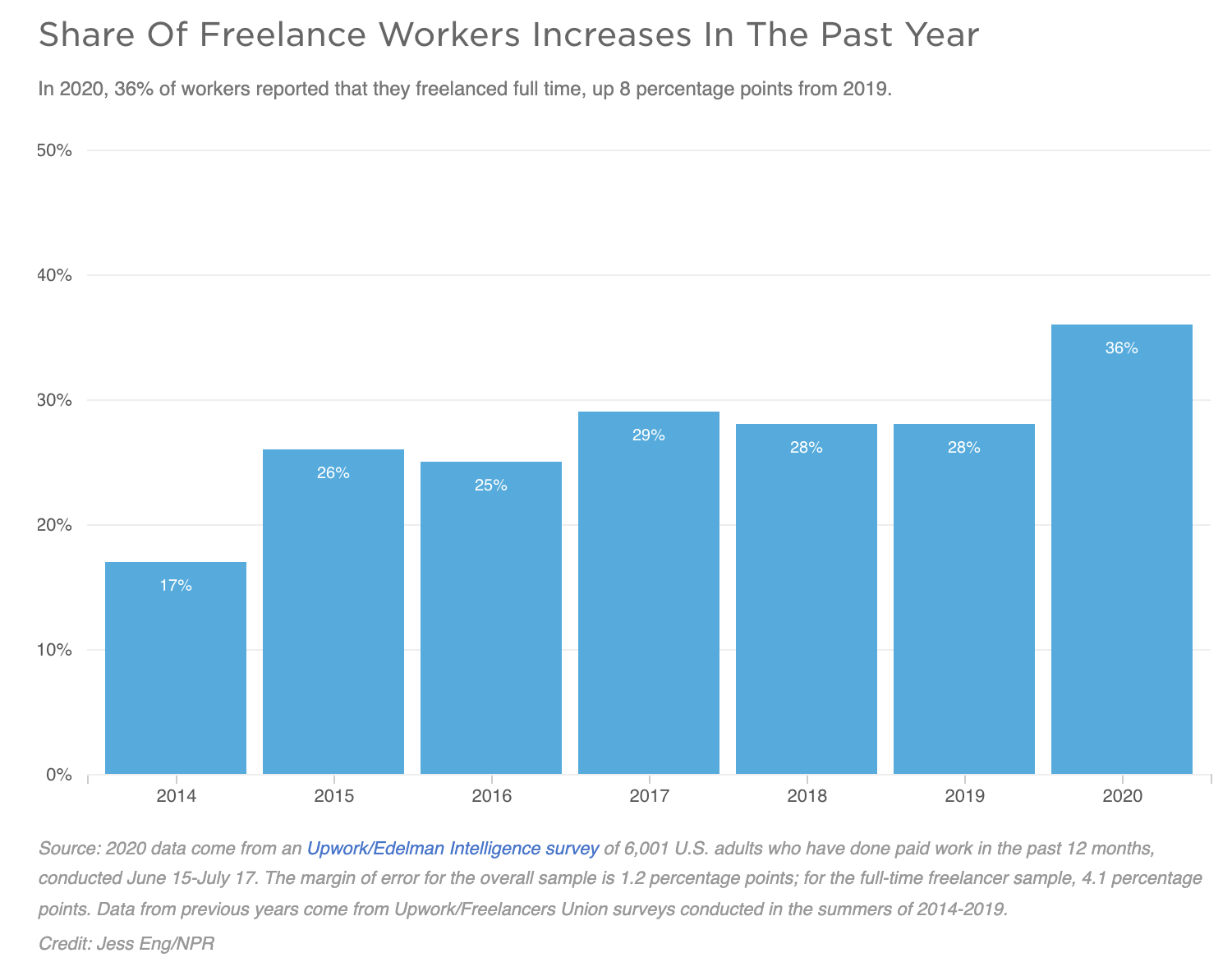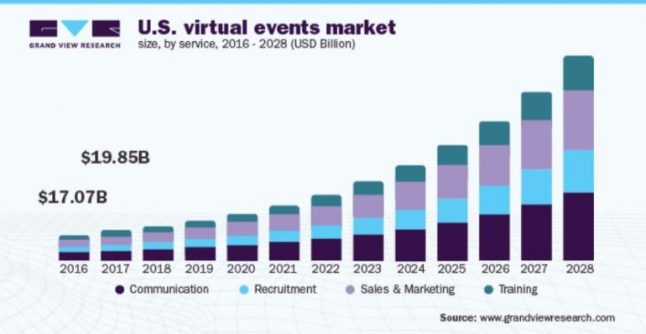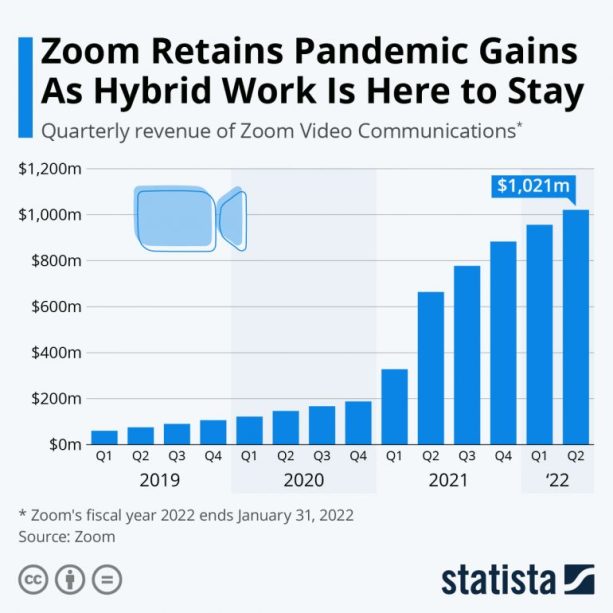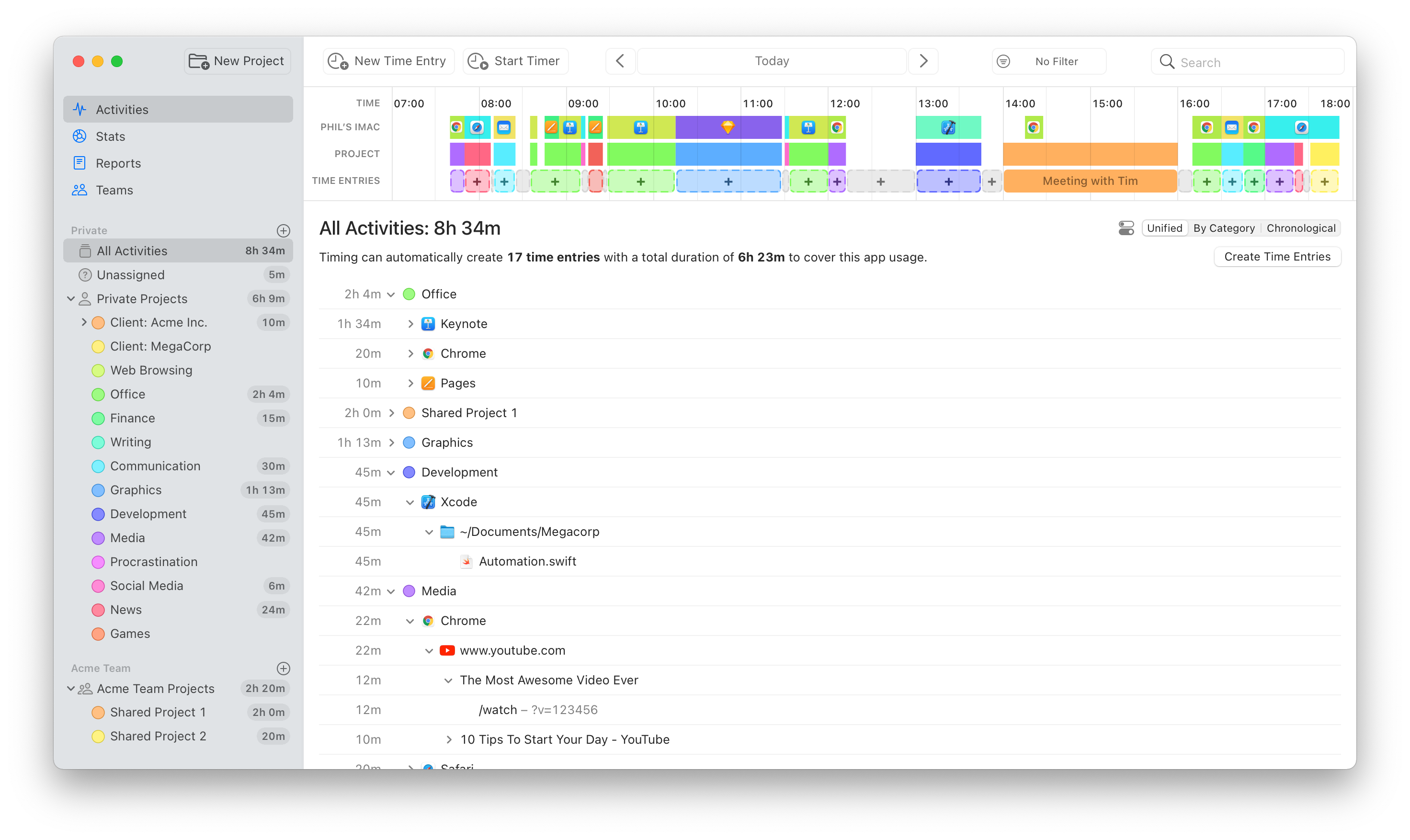Freelancing in a Post-Pandemic World

The COVID-19 pandemic changed countless industries in a myriad of ways. The concept of work is evolving. Where once work meant going all-in with a single employer, it is now more diversified and distributed. Freelancing is becoming a bigger part of our lives.
The pandemic’s damage to the workforce was quick. Millions of people were furloughed all over the world. Entire positions were eliminated, never to return. 40 million Americans were unemployed by May 2020. Millions were added to that number each week.

Image: NPR
At the time, no one could predict the pandemic’s future, so people turned to freelancing in order to survive. According to a study by freelancing platform Upwork, millions of Americans started freelancing in 2020. That increase raised the freelance portion of the workforce to 36%, and smart workforce demand forecasting indicates that this trend will continue. For the first time ever, more than a third of Americans freelance to one degree or another.
This was not a U.S. phenomenon, of course. It happened all over the world. According to Payoneer, the countries with the highest growth of freelancers (during the pandemic) were the Philippines, India, Japan, Australia, Hong Kong, and Mexico.
Fortunately, there is plenty of work available. Many employers are preferring to hire temporary, contract-based workers rather than full-time employees. Companies needed a way to survive lockdowns without damaging their revenue too much. Just like workers, businesses had to survive too.
Temporary job postings rose from 24% to 34% almost immediately when the pandemic started. Experts thought this kind of change would happen over years, when it actually took just a few months. That Upwork study also learned that 45% of hiring managers expected to freeze hiring, but 73% wanted to expand their relationships with independent professionals. By January 2021, American temporary jobs had increased by nearly 81,000.
It is entirely possible that one day the U.S. becomes a “free agent nation,” with a majority of workers offering independent services, untethered to traditional employment. The pandemic was not the start of this shift, but it was certainly an accelerant.
“This remote work experiment will also have long-term implications for the traditional ways of hiring,” Upwork’s chief economist Adam Ozimek told CNBC. “As companies embrace more remote work, they will also see that this opens up opportunities for how they think about hiring, recruiting and their workforce as a whole. They will no longer be confined to just their local labor markets but can find the most skilled talent, regardless of their location, that best meets their business needs.”
This begs these questions: What can freelancers do to be successful in the new paradigm? What steps must you take to find clients and build a sustainable business for yourself? In this article, we’re going to offer some advice on freelancing in a post-pandemic world.
No matter how you freelance, you need some tips to stay productive and lucrative in a post-pandemic world. Share on XHow to Freelance Successfully After the Pandemic
COVID-19 is not entirely behind us (and variants continue to plague us), but the world is slowly opening back up. Whether you are a freelance consultant, a month-to-month service provider, or a gig worker performing specific tasks on a flexible schedule, you need some tips to stay productive and lucrative in a post-pandemic world.
Focus on your niche
As more freelancers enter your field, the supply of workers grows. More competition means it is difficult to charge top dollar for your services because your clients have alternatives. In order to compete with other freelancers, you need to set yourself apart.
The best way to differentiate is to focus on your niche. Become really good at one thing, then seek out clients who need that one thing performed at a high level. Yes, this means that you will not get clients who want other things, but you will be able to charge a lot for that one thing.
For instance, instead of being a generalist web designer, you might focus on designing websites for restaurants. You would study the unique needs of restaurants and deliver a high-value product that general web designers cannot compete with. You will become the go-to resource for restaurants who need sites. Eventually you will find yourself designing high traffic sites for fancy Michelin star restaurants.
Furthermore, niching down does not just help you attract clients. It also makes your work simpler. If you only make restaurant sites, you do not need to worry about what retailers need, or what car dealerships need, or what landscapers need. You can design and implement clear processes that help you scale up quickly.
Keep working on your network
Networking is a critical part of maintaining a sustainable freelance business. You need a healthy network of clients, colleagues, and vendors in order to stay productive and continue to provide high-quality products and services.
But networks naturally degrade over time. People move on. They find new careers or change their contact information. Perhaps their work evolves and your interests no longer overlap. So it is important to do a little relationship-building just to maintain a stable relationship. If you want your network to grow, you will have to do a lot of networking.
Fortunately, the nature of networking has changed due to the pandemic. Eventually in-person events will start again, and it is important to go to those as well, but virtual events are here to stay. According to the Virtual Events Market Size, Share & Trends Analysis Report by Grand View Research, the virtual events market was valued at $17 billion in 2016. In 2020, it was worth $94 billion.

Image: Virtual Events Market Size, Share & Trends Analysis Report by Grand View Research
Furthermore, an IDC Virtual Events Survey, published in May 2020, uncovered that event attendees want to be engaged in several virtual ways, such as chatting with speakers and participants, downloading resources, joining community discussions, virtual “happy hours,” and more.
This means that as a freelancer, your opportunities to network are greater than ever before, you just have to engage with the right virtual opportunities. Reach out to people, make introductions, and tell them your story. And of course, let them know you are available for work.
Look into outsourcing opportunities
You may have used outsourcing in the past to improve the speed of your production or to bring in skills you lack. For instance, if you are a web developer, it might make sense to hire a designer to create the designs that you will later build. Outsourcing tasks like this can elevate your freelance business to another level and boost your productivity.
In the post-pandemic world, outsourcing will be important than ever, but also more accessible. There is a greater pool of clients, which means you can bill for more work if you outsource in clever ways. Plus there is a greater pool of freelancers who are willing to collaborate together.
Outsourcing can be as simple or as complex as you like. You could hire a virtual assistant to handle your repetitive tasks so you can focus on creative work. This is the most basic level of outsourcing.
Or you might put together a group of freelancers who routinely trade work. For instance, a content writer might work with a search engine optimizer to plan the content and a social media manager to promote it. Each party in the group could feed work to one another, effectively creating a freelancing collective. These arrangements happened all the time before the pandemic, but they will be a lot easier after.
Be flexible with your payment terms and systems
You probably have your own preferred system to get paid. Many freelancers like to send invoices at the end of the month for that month’s services. Some prefer to bill the month before so they get paid before they start working. There are countless ways to invoice.
But consider a few points: First, your clients may be working with a lot more freelancers these days, which means they have to accept multiple billing systems. Second, the pool of freelancers is much bigger, which means you will have to make some concessions if you do not want to be replaced.
Therefore, you should consider making adjustments to your workflow by letting your client take control of the billing terms. If they prefer to pay all invoices on the 25th of the month, adjust your finances accordingly to make it easier on them. If you force them to adopt your billing system, they might be willing to switch to a different service provider when he or she comes along.
That said, you do not have to give everything away. If you absolutely need to be paid upfront to cover expenses, stick with that model. If the client asks to pay 90 days late, it is okay to refuse. Just consider their situation carefully and see if you can acquiesce to make everyone’s life easier.
Reach out to new companies that ordinarily do not hire freelancers
In the past, there were plenty of companies that simply refused to hire freelancers. For whatever reason, they preferred to hire full-time employees to meet their staffing needs. But as the economy and the workforce change, those companies will be taking another look at their hiring practices and finding ways to embed freelancers into their workflows.
For you, this means there will be countless new clients to go after. They may not be actively seeking freelancers, but they will be open to the idea of hiring a contractor. So a great way to find new clients is to pitch companies who ordinarily did not hire freelancers in the past.
Working with these kinds of companies means you may need to educate them about the freelance relationship. They may try to treat you like a full-time employee at first, so you will need to set clear expectations and make sure they understand the scope of your arrangement. For instance, you will need to be absolutely clear that they are not your only client, so you will not be available at a moment’s notice.
Build out your profiles on popular freelance boards
If you have not built robust profiles on the major freelancing platforms, now is the time. In the past, it was acceptable to ignore these avenues and develop relationships directly with clients, but the future of freelancing will require a public persona that clients can find.
For a moment, imagine you are a client who has just begun to wade into the world of freelancing. You are ready to hire your first freelancer, but do not know where to start. Where would you begin, by randomly Googling for services and hoping to find someone trustworthy, or by using a brand name platform that makes freelancers sortable and scores their reputations?
Furthermore, the companies who are new to hiring freelancers enjoy the protections provided by those freelancing platforms. If something goes wrong, they know that they have some recourse to get their money back by appealing to the platform. This makes him feel more comfortable about hiring freelancers.
Yes, working through these platforms comes at a cost. For instance, Upwork charges 20% on the first $500, 10% on earnings $500.01-$10,000, and 5% on earnings $10,000.01 and up. Obviously this is not ideal and probably part of the reason you do not use freelancing platforms currently. In order to make the same money, you will need to build these fees into your pricing.
Set up a professional-looking workspace
When the pandemic hit, video conferencing took off. Conferencing software like Zoom grew tremendously in a short period of time. Evidence shows that these apps are not a fad. Remote work is here to stay.

Image: Statista
When everything went remote, suddenly everyone was peering into their coworkers’ homes. We forgave each other for messy backgrounds, poor lighting, and low video quality, but if you want your clients to take you seriously and stick with you for the long haul, you need a professional space.
If you have not already, create a space that looks good on camera. Purchase a quality web camera and a podcasting-quality microphone. You may also need some good lighting options so clients can see your face clearly. It also helps to have a good set of headphones so there’s no echo on the other end for your clients.
Finally, consider what is going on in the background of your meetings. It’s best to face your camera toward a simple, non-moving background, such as a modestly decorated wall. If there is a lot of commotion in your background (and especially if there are other people walking around), consider purchasing a basic room divider to create a sense of privacy for your meeting guests.
Jones IT has a great guide on setting up a video conferencing space in your home.
Consider how the pandemic affects your specific line of work
Depending on what you do and how you provide your service, you may need to make adjustments to changes in your particular industry or for your typical customer type. The sooner you understand which adjustments need to be made, the sooner you can make yourself a more competitive player in your industry.
For example, let’s say you make websites for restaurants. For the pandemic, your websites were fairly simple: home page, menu, contact information, etc. But now, restaurants want special features the customers ask for more often, such as online ordering and curbside pickup. A smart freelancer would learn how to provide these features in order to offer the best solutions for his or her clients.
Talk to other freelancers in your industry. Ask him if they have noticed any changes since the beginning of the pandemic. What are clients asking for? What skill do they have to learn quickly? What new services are they offering now that they didn’t offer two years ago?
If you are not already, now is a good time to start following popular trade magazines, blogs, and social media accounts. Keep an eye on their predictions, especially if those predictions are backed by post-pandemic data.
Implement the right technology for the new world
Technology has always been a critical component of freelancing. In fact, most freelancers believe technology empowers their work. But the future will require more tech and more sophisticated tools.
Beyond remote working tools, you may need to implement some tools that were not necessary in your pre-pandemic freelancing career. These tools might include a CRM, an online appointment setter (such as Calendly), or an analytics tool to monitor your revenue performance.
Productivity will be more important than ever as competition rises due to additional freelancers in the market. You will need a clear understanding of how you spend your time and how it can be optimized. The best way to track this is through a time tracking app like Timing.
Timing helps you stay on top of your time without using a timer. It automatically tracks everything you do and reports it cleanly through a dashboard. This means that Timing produces timesheets you (and your clients) can trust.

This is a powerful way to stand out from the crowd of other freelancers. You can hand your clients a detailed and accurate timesheet along with your invoice so they know exactly what they are paying for.
The Future is Bright for Freelancing
While there are many changes ahead, freelancing has a bright future. According to Upwork, most freelancers are positive about the future. 91% of freelancers say the best days are ahead for freelancing. 71% say perceptions of freelancing as a career are becoming more positive. 51% of freelancers say no amount of money would entice them to take a traditional job.
If you are willing to work hard and think critically about work, you should have no trouble adapting to the new paradigm. Use the tips and guidance we outlined above to help your freelancing business thrive in the post-pandemic world.
